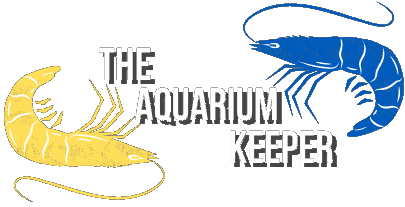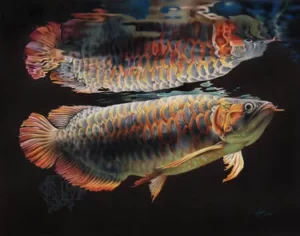
20 Good Amano Shrimp Tank Mates

Writer at The Aquarium Keeper
Amano shrimp are loved by everyone, which is why every fish keeper wants the best for their shrimp. It is always a hard choice when it comes to tank mates since some aquatic creatures do well with amano shrimp, and others can start harassing or even eating them. In this article, I will break down 20 good amano shrimp tank mates, that are in most cases safe to keep together without any problems.
Amano Shrimp Species Overview
To begin, amano shrimp are relatively very easy creatures to look after, simply because of their low needs. Amano shrimp produce very little waste and can be kept in smaller environments. A separate amano shrimp care guide can fully help understand everything about these species, but here is the basic information you should know:
- Water Temperature: 18–27 °C (64–80 °F)
- pH: 6.0–7.5
- Minimum Tank Size: 5 gallons
- Diet: Omnivore, can eat blanched vegetables, algae, wafers, pellets, flakes, leftover fish food, and even deceased tank mates
- Tank Setup: Aquarium should have a filter, light, and heater installed
- Temperament: Very peaceful
- Decorations: There are some aquatic plants, that shrimp enjoy more, but all plants are generally good. Also be sure to include rocks, driftwood, planting pots, or other decorations
- Lifespan: 1–2 years
- Size: 1.5–2 inches
- Care Level: Easy
These species are very self-reliable and do not care about other shrimp or fish, except their own kind when it comes to breeding. Amano shrimp are scavengers and tank cleaners, that help with uneaten food, and sometimes even deceased tank mates. They are very peaceful and don’t bother anyone, which is why they are so popular with beginner fish keepers.
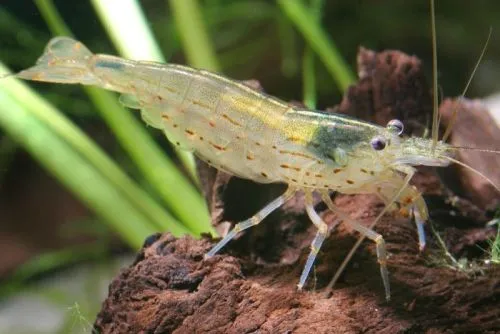
Selectively bred Amano Shrimp for purchase in the United States. Live arrival guaranteed!

Amano Shrimp Tank Mates
Most potential amano shrimp tank mates on this list are other species of shrimp, snails, small schooling fish, or slightly larger peaceful species. The two main aspects, that make an aquatic creature a good tank mate, are their water parameter requirements, and behavior.

Most species on this list share similar water requirements since all of the species are from tropical climates. When it comes to behavior, almost all potential amano shrimp tank mates are relatively peaceful, but some are very unpredictable, like betta fish. Be aware, and choose your tank mates carefully.
Neocaridina Shrimp
To begin, the first and the most compatible amano shrimp tank mate is neocaridina shrimp. Both species can easily live with each other without problems.

There are a lot of different neocaridina shrimp colors to choose from, which makes it an amazing tank mate for amano shrimp. Here is more information about these species:
- Scientific Name: Neocaridina palmata and neocaridina davidi
- Origin: China, Vietnam, Taiwan
- Price: 0.5$–8$ per shrimp
- Water Temperature: 15–30 °C (59–86 °F)
- pH: 6.5–8
- Size: 1–1.25 inches
- Preferred Environment: Neocaridina shrimp enjoy a heavily planted aquarium, with a lot of places to hide
- Diet: Omnivore, can eat algae, and other types of food, including flakes, pellets, wafers, and even deceased tank mates
- Life Expectancy: Up to 2 years
- Temperament: Extremely peaceful
- Care Level: Easy
- Minimum Tank Size: 5 gallons
Neocaridina shrimp have the same temperament as amano shrimp. They can also breed in freshwater, and do that frequently, females can get pregnant multiple times per year. There are really no existing dangers while keeping neocaridina and amano shrimp together.
One thing you should know is that neocaridina shrimp can be very sensitive to sudden water parameter changes, like temperature, or high ammonia spikes. These are very small species and don’t tolerate much, so be sure to look out for them, if you are planning these species as tank mates for amano shrimp.
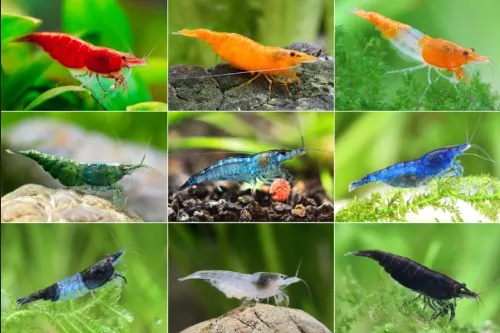
Selectively bred Neocaridina Shrimp Pack for purchase in the United States. Live arrival guaranteed!

Ghost Shrimp
Another different type of shrimp, that can be a good amano shrimp tank mate, is the ghost shrimp. These species are not as popular as neocaridina shrimp, but can also be very fun to watch. Some people can’t even tell the difference between amano shrimp and ghost shrimp.

Ghost shrimp have a unique body shape, which can sometimes look a little bent. Their body also looks slightly transparent, hence the name. Here is more information about ghost shrimp:
- Scientific Name: Palaemonetes paludosus
- Origin: North America
- Price: 0.5$–2$ per shrimp
- Water Temperature: 22–28 °C (72–82 °F)
- pH: 7–8
- Size: 1.25–1.5 inches
- Preferred Environment: Similar to neocaridina, ghost shrimp enjoy a heavily planted aquarium, with lots of places to hide in
- Diet: Omnivore, mainly feeds on algae, sinking pellets, food leftovers, deceased tank mates
- Life Expectancy: Up to 1 year
- Temperament: Extremely peaceful
- Care Level: Easy
- Minimum Tank Size: 5 gallons
Similar to the previous potential tank mate, ghost shrimp can also breed easily in freshwater, which they frequently do. Ghost shrimp are also sensitive to drastic water changes, because of their small size and weak immune system.
Nerite Snail
When it comes to aquatic snails, nerites are probably the most popular pick amongst hobbyists. Nerite snail is an excellent tank mate for amano shrimp.

There are a lot of different types of nerite snails you can choose from, ranging from the basic zebra nerites to the rare batman nerite snails. Here is more information about these species:
- Scientific Name: Neritina Natalensis
- Origin: Northeastern, Southern Africa
- Price: 2$–4$ per snail
- Water Temperature: 20–26 °C (60–79 °F)
- pH: 6.0–8
- Size: 1.25–1.5 inches
- Preferred Environment: Nerite snails really do not care about their environment, they interact with anything that surrounds them, and hide in their own shell
- Diet: Herbivore, mainly eats algae, dead plant material, and sometimes leftover fish food
- Life Expectancy: Up to 2 years
- Temperament: Extremely peaceful
- Care Level: Easy
- Minimum Tank Size: 5 gallons
When it comes to compatibility and characteristics, nerite snails don’t bother anyone in the tank, especially amano shrimp. These creatures mind their own business all the time, climbing decorations and searching for food.
One thing that could annoy you about this tank mate, is that nerite snails usually lay their eggs everywhere, including decorations and even glass. These eggs don’t hatch in freshwater, and can sometimes be hard to remove, so it can be a nuisance to some people.
Mystery Snail
Moving on, another popular snail pick in the hobby is the mystery snail. Some people also like to call it the apple snail, hence the most popular yellow shell, that resembles an apple.
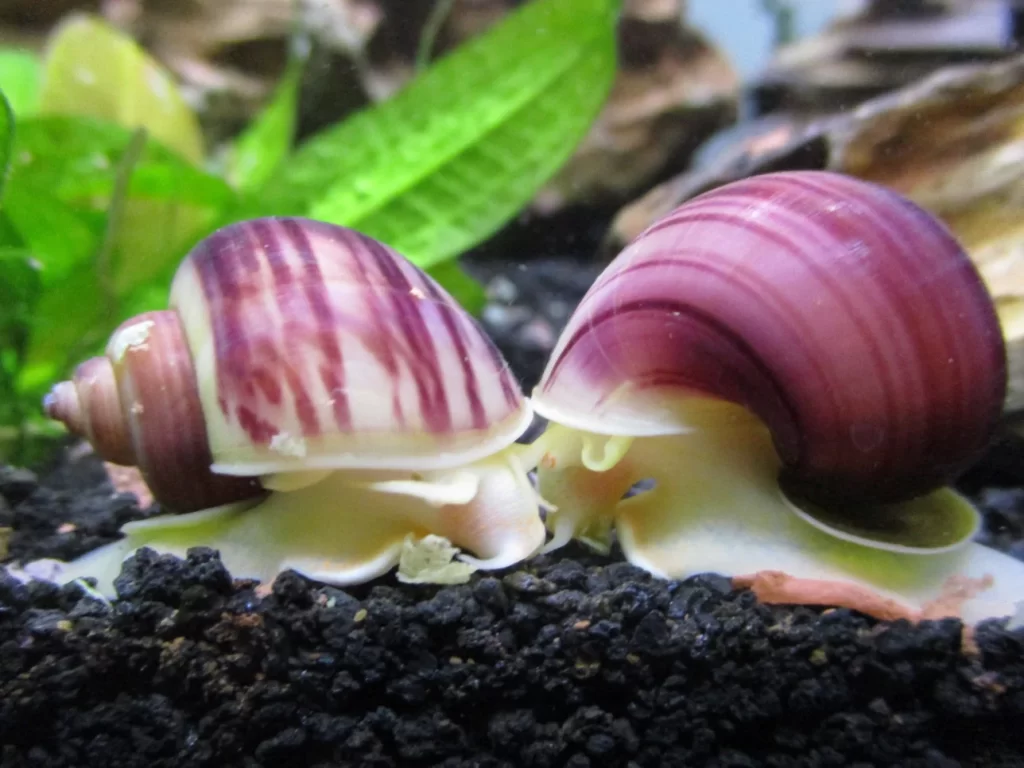
Similar to nerites, there are a lot of different colors to choose from when it comes to mystery snails. Here is more information about these species:
- Scientific Name: Pomacea bridgesii
- Origin: Asia
- Price: 1$–5$ per shrimp
- Water Temperature: 21–28 °C (68–82 °F)
- pH: 6.5–8
- Size: 1.25–2 inches
- Preferred Environment: Similar to nerites, mystery snails really don’t care about their surroundings, they interact with all decorations
- Diet: Herbivore, eats algae, dead plant material, and leftover fish food
- Life Expectancy: Up to 2 years
- Temperament: Extremely peaceful
- Care Level: Easy
- Minimum Tank Size: 5 gallons
Mystery snails can be an excellent amano shrimp tank mates, simply because both these species live their own life and don’t bother each other. Sometimes mystery snails can push amano shrimp for food, but that is pretty much the amount of contact these creatures will have in your tank.
One cool thing about these species, is that mystery snails are usually very clumsy and fun to watch. A lot of the time they climb up things, that shouldn’t be climbed, and fall down back to the bottom of the tank.
Neon Tetra
The first nano-schooling fish on this list is the neon tetra. These species can definitely be good tank mates for amano shrimp.
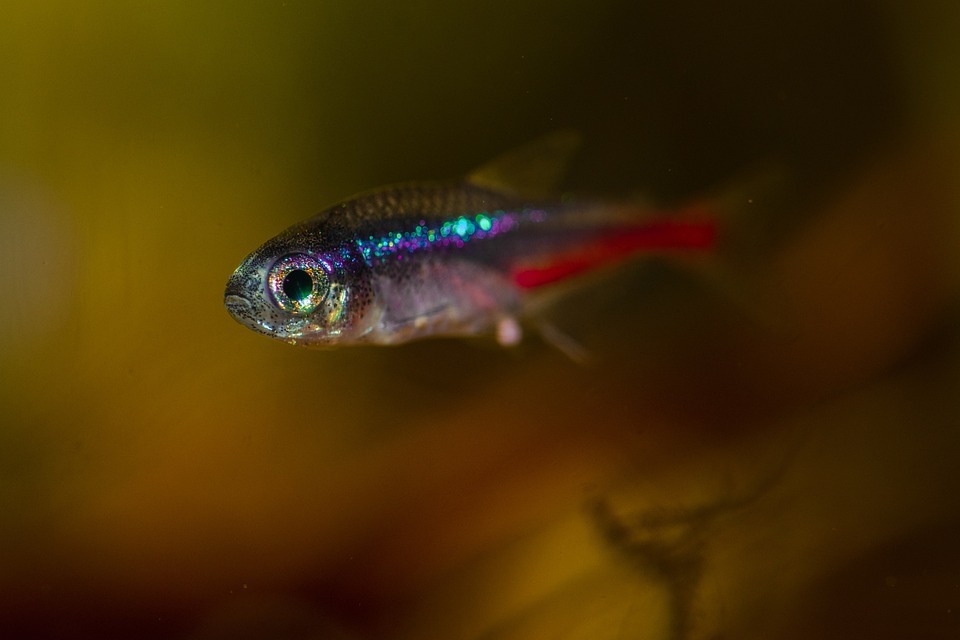
Neon tetras are very basic, and probably the most popular schooling fish in the aquarium hobby. They are very popular for their neon stripe, which can be seen from afar. Here is more information about neon tetras:
- Scientific Name: Paracheirodon innesi
- Origin: South America
- Price: 1$–2$ per fish
- Water Temperature: 23–28 °C (74–82 °F)
- pH: 6.0–8
- Size: 1.25–1.5 inches
- Preferred Environment: Neon tetras can sometimes be shy, especially in the beginning, they enjoy a lot of different plant types and hiding places. Neon tetras also need a lot of open space to swim
- Diet: Omnivore, mainly eats fish flakes, sinking pellets, blood worms, and insect larvae, can also sometimes graze on algae
- Life Expectancy: Up to 8 years
- Temperament: Peaceful
- Care Level: Easy
- Minimum Tank Size: 15 gallons
As a schooling fish, neon tetras feel better together, so if you are choosing these species as a tank mate, make sure that you can get at least 8 of them. For that, you would need at least a 15-gallon aquarium. When it comes to compatibility, both species really don’t mind each other.
Neon tetras don’t see amano shrimp as food, because of their size. Sometimes neon tetras can become fin nippers, but it mainly happens with fish, that have large fins, and that spend time in the same part of the aquarium.
Cardinal Tetra
Moving on, an almost identical fish to the neon tetra is the cardinal tetra. It is also a good tank mate for amano shrimp, because cardinal tetras are peaceful and can live in the same water conditions.

Cardinal tetras act the same as neons, but are larger and have a slightly different appearances. Instead of having just a little marking on them, cardinal tetras are very red, raging from head to tail. They also have the classic blue stripe, which makes them stand out in an aquarium.
- Scientific Name: Paracheirodon axelrodi
- Origin: South America
- Price: 1$–2$ per fish
- Water Temperature: 22–28 °C (72–82 °F)
- pH: 6.5–8
- Size: 1.5–2 inches
- Preferred Environment: Being a schooling fish from South America, cardinals enjoy heavily planted aquariums with hiding spaces and some swimming space
- Diet: Omnivore, mainly eats fish flakes, sinking pellets, insect larvae, and blood worms, can also sometimes eat algae
- Life Expectancy: Up to 5 years
- Temperament: Peaceful
- Care Level: Easy
- Minimum Tank Size: 15 gallons
Amano shrimp will do just fine with cardinal tetras. Both species spend most of their time in different parts of the tanks and interact only when there is food. Cardinal tetras can sometimes push neons when there is food, but that is perfectly normal.
Ember Tetra
Another great schooling fish, that can live with amano shrimp is ember tetra. If you want some orange and golden color in your aquarium, this fish is right for you.

Ember tetras are slightly smaller than neon tetras but portray very similar behavior. Here is more information about these species:
- Scientific Name:Hyphessobrycon amandae
- Origin: South America
- Price: 1$–2$ per fish
- Water Temperature: 22–28 °C (72–82 °F)
- pH: 6.5–8
- Size: 0.8–1 inches
- Preferred Environment: Ember tetras enjoy a lot of different plants in their environment. These species can also be shy, so be sure to have rocks and driftwood, that would create hiding places around the tank
- Diet: Omnivore, mainly eats fish flakes, sinking pellets, blood worms, brine shrimp
- Life Expectancy: Up to 8 years
- Temperament: Peaceful
- Care Level: Easy
- Minimum Tank Size: 15 gallons
These species are sporadic swimmers and enjoy schooling very much. They will simply bother your amano shrimp because they don’t see it as food or as a threat. Similar to neon tetras, ember tetras spend most of their time in the middle section of the aquarium.
Rummy Nose Tetra
Moving on, a slightly larger, and more interesting schooling fish, that is a good tank mate for amano shrimp is the rummy nose tetra.

Rummy nose tetras have a red face with red eyes, hence the name, silver body, and white and black tail. They are one of the most unique-looking fish on this list. Here is more information about rummy nose tetras:
- Scientific Name: Hemigrammus rhodostomus
- Origin: South America
- Price: 2$–3$ per fish
- Water Temperature: 20–28 °C (68–80 °F)
- pH: 6.5–7
- Size: 2–2.5 inches
- Preferred Environment: Rummy nose tetras are larger schooling fish, which means they need more space for swimming. These species also need plants, rock, and driftwood to replicate their natural environment.
- Diet: Omnivore, eats fish flakes, pellets, blood worms, brine shrimp, sometimes grazes on algae
- Life Expectancy: Up to 6 years
- Temperament: Extremely peaceful
- Care Level: Easy
- Minimum Tank Size: 20 gallons
These species are way larger, compared to other schooling fish previously mentioned on this list. That is why it is recommended to get at least a 20-gallon aquarium, that could house a school of rummy nose tetras. Amano shrimp can easily live with rummy nose tetras, they are too small to eat or harm amano shrimp.
Galaxy Rasbora
Another beautiful and great tank mate on this list is the galaxy rasbora or celestial pearl danio. It is an excellent amano shrimp tank mate, since it is very peaceful, and fun to look at.

Galaxy rasboras portray a shoaling behavior, which means they like to interact with other fish and swim together. Galaxy rasboras have orange fins, blueish bodies, and yellow dots everywhere. Here is more information about these species:
- Scientific Name: Danio margaritatus
- Origin: Asia
- Price: 3$–5$ per shrimp
- Water Temperature: 18–27 °C (66–80 °F)
- pH: 6.5–7.5
- Size: 1–1.5 inches
- Preferred Environment: Galaxy rasboras are very curious creatures, and sometimes portray shy behavior. Make sure there are a lot of plants and hiding places in your aquarium
- Diet: Omnivore, can eat flakes, pellets, blood worms, insect larvae, algae
- Life Expectancy: Up to 5 years
- Temperament: Extremely peaceful
- Care Level: Medium
- Minimum Tank Size: 15 gallons
It is possible, that galaxy rasboras and amano shrimp will see each other more often because galaxy rasboras really enjoy exploring their tank. These species tend to be individualistic fish, and are not so grouped up, compared to neon tetras.
Chili Rasbora
The smallest schooling fish on this list is chili rasbora. It is an excellent tank mate for amano shrimp, simply because of their size and temperament.

Chili rasbora is very red, hence the name, and also has a blueish stripe on its body. Sometimes these species can lose their redness if they feel threatened. They get easily scared because chili rasbora is so small and vulnerable.
- Scientific Name: Boraras brigittae
- Origin: Indonesia
- Price: 1$–3$ per fish
- Water Temperature: 20–28 °C (68–82 °F)
- pH: 5–7
- Size: 0.75–1 inches
- Preferred Environment: Due to their size, chili rasboras are relatively shy, and like to stay in larger groups. Be sure to have lots of live plants, and create hiding places using rocks and driftwood
- Diet: Omnivore, can eat algae, fish flakes, pellets, bloodworms, insect larvae, brine shrimp
- Life Expectancy: Up to 8 years
- Temperament: Extremely peaceful
- Care Level: Easy
- Minimum Tank Size: 10 gallons
There is simply no aquatic creature, that chili rasbora can harm. These species can even have a harder time feeding, due to their small mouths. Be sure to crush the flakes or pellets when feeding chili rasbora. It is an amazing fish but looks way better in larger schools.
Otocinclus
The first bottom-dwelling fish on this list is otocinclus. Bottom-dwellers will interact with amano shrimp way more, but that does not mean they can be bad amano shrimp tank mates.

These species are also called “dwarf-sucking fish” and feel best when in larger groups. Otocincluses are very small and can get scared more easily. Here is more information about these species:
- Scientific Name: Otocinclus vestitus
- Origin: South America
- Price: 3$–5$ per fish
- Water Temperature: 22–28 °C (72–82 °F)
- pH: 6.5–7.5
- Size: 1–1.5 inches
- Preferred Environment: Sand should be the preferred substrate for these species, also otocinclus fish can be shy, be sure to include lots of plants
- Diet: Herbivore, mainly eats algae, dead plant material, algae wafers
- Life Expectancy: Up to 6 years
- Temperament: Extremely peaceful
- Care Level: Easy
- Minimum Tank Size: 15 gallons
One cool factor about otocincluses, is that they are herbivores, and mainly eat algae, and dead plant material. This is a good factor because they won’t see amano shrimp as a food source and would leave it alone.
Pygmy Corydora
Moving on, another bottom-dweller, that is suitable to be a tank mate for amano shrimp, is the pygmy corydora. These species are also called “dwarf corys” and are the smallest corydora species in the aquarium hobby.
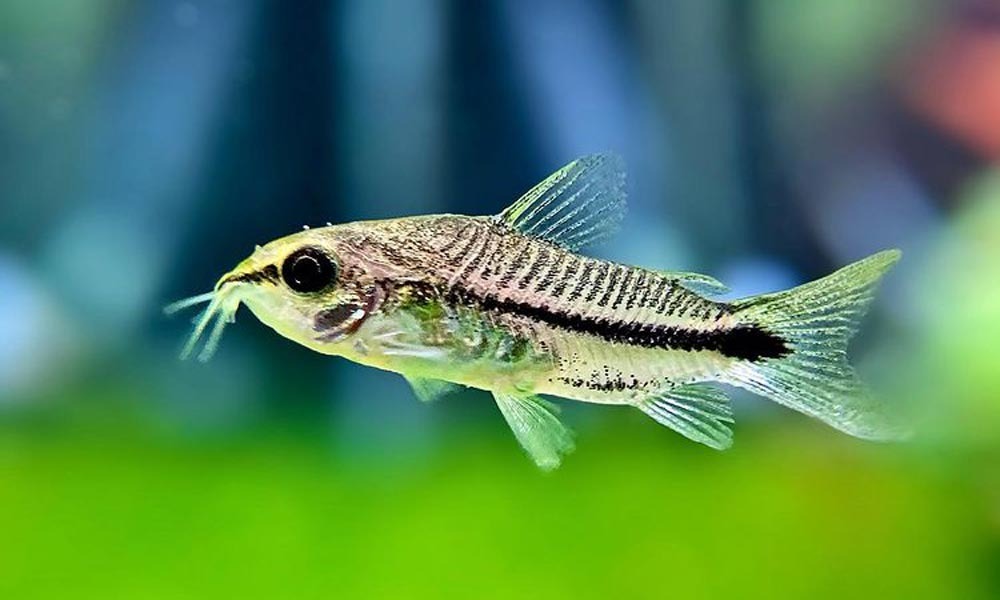
Pygmy corydora is a very simple fish in terms of appearance. It has a silver body, and a black stripe in the middle. Here is more information about pygmy corydoras:
- Scientific Name: Corydoras pygmaeus
- Origin: South America
- Price: 3$–5$ per shrimp
- Water Temperature: 22–28 °C (72–82 °F)
- pH: 6.5–8
- Size: 0.75–1 inch
- Preferred Environment: Pygmy corydoras do best when the substrate of the tank is sand. Also be sure to have live plants, because these species like to hide and rest on plant leaves
- Diet: Omnivore, can eat algae, sinking pellets, algae wafers, bloodworms
- Life Expectancy: Up to 3 years
- Temperament: Extremely peaceful
- Care Level: Easy
- Minimum Tank Size: 15 gallons
These species are also indeed schooling fish, and feel best in larger groups. Unlike otocinclus, pygmy corydora is an omnivore, which means it can eat protein-based and plant-based food. Both amano shrimp and pygmy corydora can compete for food at the bottom of the tank, but that is not a problem, and it won’t cause any significant aggression between the two species.
Kuhli Loach
A more unique-looking bottom-dweller is the kuhli loach. These species more look like a snake, than fish. Nevertheless, they are a good tank mate for amano shrimp.

Kuhli loaches are nocturnal creatures, which means they don’t usually appear in day time in the aquarium. Here is more useful information about kuhli loaches:
- Scientific Name: Pangio kuhlii
- Origin: Indonesia
- Price: 3$–5$ per loach
- Water Temperature: 24–30 °C (75–86 °F)
- pH: 6.5–7.5
- Size: 3–4 inches
- Preferred Environment: Kuhli loaches like sand more in their tanks, because these species are bottom-dwellers. Plants are also important since these species like to hide a lot
- Diet: Omnivore, can eat algae, sinking pellets, wafers, bloodworms, and other fish food leftovers
- Life Expectancy: Up to 14 years
- Temperament: Peaceful
- Care Level: Easy
- Minimum Tank Size: 20 gallons
Some people might argue, that kuhli loaches eat shrimp and that these two species should not be housed together. This might be true, but that solely depends on the size of both species. If you have a huge kuhli loach, and a baby amano shrimp, chances are higher, that the amano shrimp could get eaten. If you want kuhli loach as a tank mate, I recommend getting a smaller one first.
Betta Fish
One of the more challenging amano shrimp tank mates is the betta fish. Some people have success with this combination, some really don’t. Nevertheless, it is worth mentioning this fish on this list.
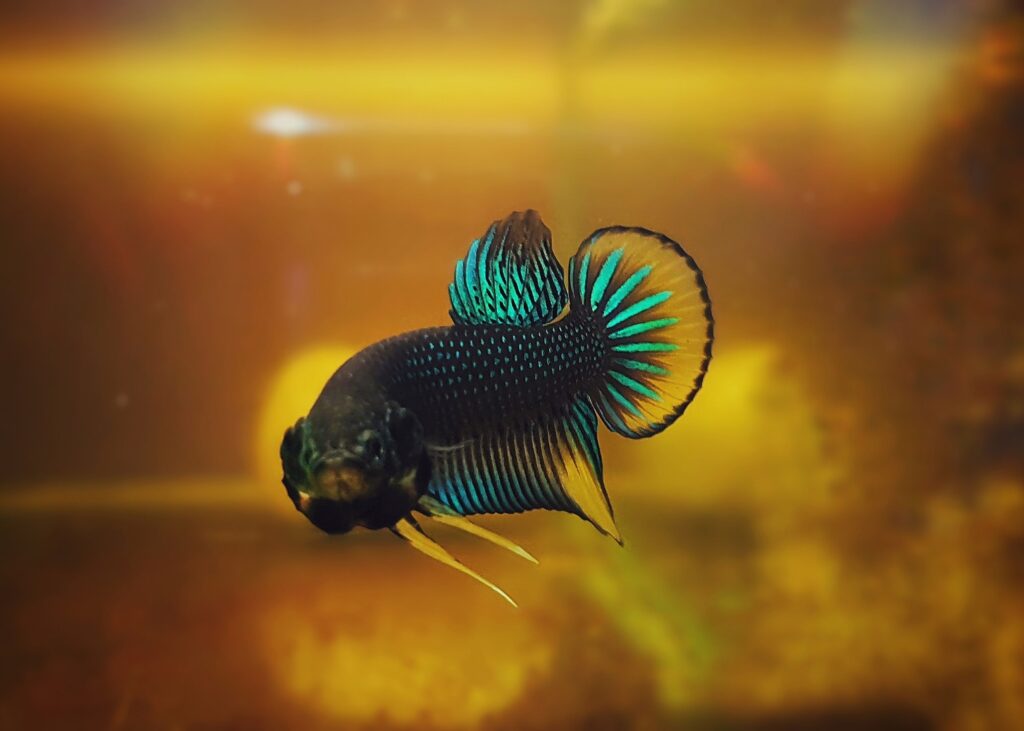
Every betta fish is different, in terms of character and appearance. There are long-finned betta fish, who are slower. There are also short-finned bettas, who tend to be more aggressive and faster. Here is more information about this fish:
- Scientific Name: Betta splendens
- Origin: Indonesia, Asia
- Price: Depends on the type of betta fish
- Water Temperature: 23–30 °C (73–86 °F)
- pH: 6.5–8
- Size: 2–3 inches
- Preferred Environment: Betta fish enjoy a heavily-planted aquarium, including all sizes and types of plants. Make sure to add a lot of places to explore, to keep your betta occupied
- Diet: Omnivore, can occasionally graze on algae or plant roots, but mainly eats fish flakes, pellets, bloodworms, brine shrimp, insect larvae
- Life Expectancy: Up to 5 years
- Temperament: Depends on the betta fish character
- Care Level: Moderate
- Minimum Tank Size: 5 gallons
If you want to successfully keep betta fish and amano shrimp together, I encourage you to have a lot of different plants and hiding places in your tank. Some betta fish are very aggressive and can kill any tank mate, others tend to not care about anything.
For a higher success chance, try to go for a long-finned betta fish, which is slower and less likely to be aggressive. In most cases, amano shrimp are too big to be eaten by betta fish, but they might still be harassed.
Sparkling Gourami
Moving on, another unique fish, that made this list, is the sparkling gourami. These species are not schooling fish but like their own company.

Sparkling gourami is known for eating baby shrimp, but since amano shrimp can’t breed in freshwater, it is a good potential tank mate for amano shrimp. Here is more information about these species:
- Scientific Name: Trichopsis pumila
- Origin: Southeast Asia
- Price: 3$–5$ per shrimp
- Water Temperature: 22–28 °C (72–82 °F)
- pH: 6.5–7.5
- Size: 1.25–1.5 inches
- Preferred Environment: Sparkling gourami likes a heavily-planted tank, with a lot of different hiding spots, including rocks and driftwood
- Diet: Omnivore, can graze on algae or plant material, also mainly eats fish flakes, pellets, bloodworms, brine shrimp
- Life Expectancy: Up to 4 years
- Temperament: Peaceful
- Care Level: Moderate
- Minimum Tank Size: 15 gallons
Amano shrimp and sparkling gourami can easily coexist together. Sparkling gourami is usually peaceful, and spend most of the time exploring the tank, hanging out in all tank places. Amano shrimp is simply too big to be eaten by sparkling gourami.
Bristlestone Pleco
Another bottom-dweller fish, that is suitable to be an amano shrimp tank mate, is the bristlenose pleco. These species grow to be very large, so be sure you have the capacity for this fish.

There are a lot of different bristlenose pleco types to choose from, ranging from the most basic black and white ones to the rarer spotted bristlenose plecos. Here is more information about this fish:
- Scientific Name: Ancistrus cirrhosus
- Origin: South America
- Price: 3$–5$ per fish
- Water Temperature: 22–30 °C (72–86 °F)
- pH: 6.5–7.5
- Size: 3–5 inches
- Preferred Environment: Sand substrate, rocks and driftwood, and lots of live aquarium plants
- Diet: Herbivore/omnivore, mainly eats algae, dead plant material, algae wafers, but occasionally can also eat other fish food leftovers
- Life Expectancy: Up to 15 years
- Temperament: Peaceful
- Care Level: Easy
- Minimum Tank Size: 30 gallons
These species are not aggressive at all, and can only portray some sort of aggression towards other plecos or fish. That can happen if there is not enough space in the tank. As we mentioned before, bristlenose plecos grow relatively large and need a lot of space. When it comes to compatibility between amano shrimp and bristlenose pleco, these species can sometimes push each other for food, but that is it in terms of aggression.
Hatchet Fish
One of the most interesting and less popular fish on this list is the hatchet fish. This is a top-dweller, that mainly stays near the surface, which is why it is a perfect tank mate for amano shrimp.

Hatchet fish are nothing special when it comes to appearance. These species have a big belly and are mostly silver in color. Here is more information about these species:
- Scientific Name: Gasteropelecidae
- Origin: South America
- Price: 4$–6$ per fish
- Water Temperature: 22–28 °C (72–82 °F)
- pH: 6–7.5
- Size: 2–2.5 inches
- Preferred Environment: Include floating plants in the aquarium, since these species spend most of the time near the surface
- Diet: Carnivore, mainly eats protein-rich flakes, brine shrimp, blood worms
- Life Expectancy: Up to 5 years
- Temperament: Peaceful
- Care Level: Moderate
- Minimum Tank Size: 20 gallons
Amano fish can easily live with hatchet fish, simply because both species spend most of their time in different parts of the tank. Also, hatchet fish are not aggressive fish at all, which is another reason for being a good potential tank mate.
Guppies
Moving on, this list is not full if I don’t mention one of the most popular species, which are basic guppies. They are loved by everyone, and can definitely live with amano shrimp in the same tank.

Guppies come in a lot of different colors, mainly the males are more colorful and vibrant, while females show less coloration and are slightly larger. Here is more information about these species:
- Scientific Name: Poecilia reticulata
- Origin: South America
- Price: Depends on appearance
- Water Temperature: 21–29 °C (70–84 °F)
- pH: 6–8
- Size: 1.5–2.5 inches
- Preferred Environment: Guppies are very active, and enjoy interacting with their environment. Be sure to include plants, rocks, and driftwood in their tank
- Diet: Omnivore, occasionally eats algae, mainly consumes fish flakes, pellets, blood worms, insect larvae, brine shrimp
- Life Expectancy: Up to 2 years
- Temperament: Peaceful
- Care Level: Easy
- Minimum Tank Size: 10 gallons
Guppies are very versatile when it comes to water conditions, and they can eat pretty much anything, that fits in their mouth. Amano shrimp can be tank mates with guppies, simply because amanos are too large to be eaten.
Cherry Barb
Another amazing-looking fish is the cherry barb. This is a small-schooling fish, that simply stands out in any aquarium.

Cherry barbs are very unique in appearance. They have red or orange bodies, with little black spots marking all around the body. These species are relatively peaceful and would do well with amano shrimp.
- Scientific Name: Puntius titteya
- Origin: Sri Lanka
- Price: 3$–5$ per fish
- Water Temperature: 22–28 °C (72–82 °F)
- pH: 6–8
- Size: 1.5–2 inches
- Preferred Environment: Cherry barbs are very active fish, so be sure to have some swimming space for them in the tank. Also include rocks, driftwood, and live plants, to replicate their natural environment
- Diet: Omnivore, can eat algae, fish flakes, pellets, blood worms, insect larvae, brine shrimp
- Life Expectancy: Up to 5 years
- Temperament: Peaceful
- Care Level: Easy
- Minimum Tank Size: 30 gallons
These species need a slightly larger tank, so be sure to have the right capabilities if you want cherry barbs. Amano shrimp might encounter these fish, but because they are peaceful, nothing would happen. Cherry barbs like to explore their tank, which is why they might run into amano shrimp.
Bamboo Shrimp
Finally, the last species on this list is bamboo shrimp. These species are not that popular and might be hard to find in some places, but they make an excellent tank mate for amano shrimp.

Bamboo shrimp are slightly larger than amano shrimp, and mainly come in brown, grey, and even slightly orange colors. They also have a white line on their back, that goes from head to tail. Here is more information about these species:
- Scientific Name: Atyopsis moluccensis
- Origin: Southeast Asia
- Price: 5$–10$ per shrimp
- Water Temperature: 22–28 °C (72–82 °F)
- pH: 6.5–7.5
- Size: 2–3 inches
- Preferred Environment: Plants are essential if you want to keep these species. Shrimp like to hide, and plants provide cover, also an extra food source. Don’t forget to include rocks and driftwood in your tank setup
- Diet: Omnivore, can eat algae, leftover fish food, algae pellets, and even deceased tank mates
- Life Expectancy: Up to 2 years
- Temperament: Extremely peaceful
- Care Level: Easy
- Minimum Tank Size: 20 gallons
Bamboo shrimp are excellent tank mates for amano shrimp, because these species are both very peaceful, eat the same food, and almost even act the same. Mixing different types of shrimp in the same tank usually results in no problems, and are becoming more and more popular in this hobby.
Frequently Asked Questions
Are Amano Shrimp Aggressive?
Amano shrimp are not aggressive at all. These creatures mind their own business, searching for food and exploring their surroundings. They don’t portray any territorial aggression, and can only be pushy when it comes to food.
How Many Amano Shrimp Should be Kept Together?
Amano shrimp really don’t get lonely, so you can easily keep just one in a minimum of a 5-gallon aquarium. Keeping more amano shrimp is always more fun to watch, but that depends on your setup.
Writer's Thoughts
To conclude, amano shrimp are great aquatic creatures, which can easily be kept together with a lot of species. Make sure to choose the right fish, which would do good in your size aquarium.
If you enjoyed reading our article about amano shrimp tank mates, please feel free to share it with your friends by clicking the social media buttons below:
